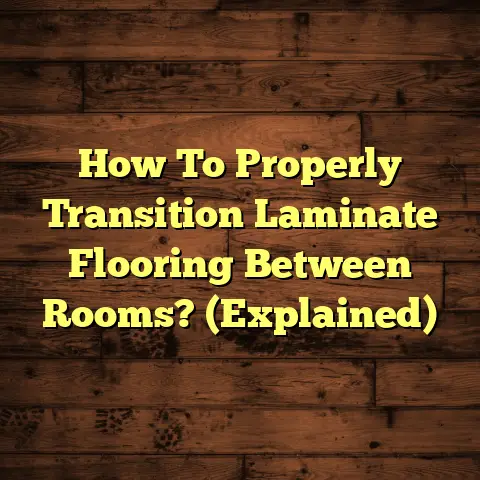What is a Tile Vent? (1 Code Violation!)
Ventilation is the unsung hero of a healthy home. It’s the key to kicking out stale air, preventing moisture buildup, and keeping your indoor air quality top-notch.
Think of it like this: your house needs to breathe!
Tile vents? They’re a part of that breathing process. These little guys are designed to help air circulate, especially in areas prone to dampness.
We’re talking about bathrooms, kitchens, and basements – the usual suspects when it comes to humidity.
Understanding tile vents isn’t just about knowing what they are, it’s about knowing why they matter.
And a little secret? Ignoring them can lead to some serious code violations. Let’s dive in!
Section 1: Room-Specific Needs
Alright, let’s get specific. Every room in your house has different ventilation needs. It all comes down to how you use the space.
1.1 Bathrooms
Bathrooms are humidity factories! Showers, baths, even just washing your hands… it all adds up.
Without proper ventilation, that moisture can lead to mold and mildew. And trust me, nobody wants that.
Tile vents can be a lifesaver here. They help exhaust that damp air, keeping your bathroom dry and healthy.
Where to put them?
Typically, you’ll find tile vents near the shower or tub, or even right above the toilet. The goal is to capture that moisture right at the source.
Proper air circulation in bathrooms is crucial. I’ve seen bathrooms where the only ventilation was a tiny window.
That’s just not enough! A good tile vent, combined with an exhaust fan, can make a world of difference.
1.2 Kitchens
Kitchens are another hotspot for ventilation needs. Think about all the cooking fumes, steam from boiling pots, and general moisture.
All that can create a pretty unhealthy environment.
Tile vents play a big role in keeping your kitchen air clean and fresh.
They help remove those cooking odors and prevent grease buildup, which can be a real pain to clean.
Placement is key here, too.
I often recommend placing tile vents near the stove or above the sink. This helps capture the most concentrated sources of fumes and moisture.
When designing a kitchen, I always consider the placement of appliances and cabinetry.
You want the tile vent to be effective without being an eyesore.
1.3 Basements
Basements are notorious for being damp and poorly ventilated. It’s just the nature of being underground.
This can lead to all sorts of problems, from mold and mildew to musty odors. Yuck!
Tile vents can be a valuable tool in mitigating these issues. They help circulate air and reduce moisture buildup.
However, in basements, tile vents are often just one piece of the puzzle.
You might also need a dehumidifier, sump pump, or even a more robust ventilation system.
Combining solutions is often the best approach.
I’ve seen some pretty creative uses of tile vents in basements. Sometimes, it’s as simple as adding a vent to an existing window well.
Other times, it involves more extensive ductwork and ventilation planning.
1.4 Living Areas
Okay, so living rooms and bedrooms might not seem like the most obvious places for tile vents. But they still have ventilation needs!
Think about things like pet dander, dust, and even just the air we breathe out.
Tile vents can contribute to a more balanced airflow throughout the entire home, not just in those high-moisture areas.
A common misconception is that tile vents are only for bathrooms and kitchens.
That’s simply not true! They can be used in any room to improve air quality and circulation.
When it comes to living spaces, aesthetics are important. Luckily, tile vents come in a variety of styles and designs that can blend seamlessly with your decor.
You don’t have to sacrifice style for functionality.
Section 2: Understanding Tile Vents
So, what exactly is a tile vent? Let’s break it down.
A tile vent is essentially a vent cover, usually made of metal or plastic, that’s designed to be installed in a tile floor or wall.
It allows air to flow in or out of a space, depending on its purpose.
Types of tile vents:
- Supply vents: These deliver fresh air into a room.
- Exhaust vents: These remove stale or moist air from a room.
- Return vents: These pull air back into the HVAC system for recirculation.
The installation process is pretty straightforward.
It involves cutting a hole in the tile, inserting the vent, and securing it in place.
Proper placement is crucial to ensure that the vent is aligned with the ductwork and functioning correctly.
Tile vent styles and designs?
You have tons of options! From simple, minimalist designs to more decorative and ornate styles, there’s a tile vent to suit every taste.
You can even find tile vents that are designed to match specific tile patterns or colors.
Section 3: The Code Violation Aspect
Okay, let’s talk about the not-so-fun stuff: building codes.
Building codes are a set of rules and regulations that ensure safety and functionality in home construction and renovation.
They cover everything from electrical wiring to plumbing to ventilation.
Why do they matter?
Because they’re designed to protect you and your family! Ignoring building codes can lead to safety hazards, structural problems, and even legal issues.
So, what’s the code violation associated with tile vents?
It typically boils down to one or more of these issues:
- Improper placement: Placing a tile vent in the wrong location can render it ineffective.
- Inadequate sizing: Using a tile vent that’s too small for the space it’s supposed to ventilate.
- Failure to connect to a duct system: A tile vent that’s not connected to a duct system is basically just a hole in your floor or wall.
What happens if you ignore these code violations?
Well, for starters, you could be putting your family at risk. Poor ventilation can lead to mold growth, which can cause respiratory problems and other health issues.
You could also be facing increased maintenance costs down the road.
Mold and mildew can damage your home’s structure, leading to expensive repairs.
And let’s not forget about the potential legal consequences. If you’re caught violating building codes, you could be fined or even forced to tear down your work.
Section 4: Maintenance and Troubleshooting
Like any other part of your home, tile vents require regular maintenance to ensure optimal performance.
Here’s a quick guide:
- Regular cleaning: Use a vacuum cleaner or brush to remove dust and debris from the vent.
- Check for clogs: Make sure that the vent is not blocked by furniture or other objects.
- Inspect for damage: Look for cracks, rust, or other signs of wear and tear.
Common issues:
- Clogs: Dust, hair, and other debris can accumulate in the vent, restricting airflow.
- Improper airflow: If the vent is not properly connected to the duct system, it may not be providing adequate ventilation.
- Drafts: A leaky tile vent can cause drafts, making your home uncomfortable and increasing your energy bills.
When to call a pro?
If you’re not comfortable performing maintenance or troubleshooting on your own, it’s always best to consult a professional.
A qualified HVAC technician can diagnose and repair any issues with your tile vents, ensuring that they’re functioning properly and in compliance with building codes.
Conclusion
So, there you have it! A comprehensive look at tile vents, their importance in various rooms, and the potential pitfalls of code violations.
Remember, proper ventilation is essential for maintaining a healthy and comfortable home environment.
Tile vents are a valuable tool in achieving that goal, but they need to be installed and maintained correctly.
Take a look around your home.
Do you have adequate ventilation in your bathrooms, kitchens, and basements?
Are your tile vents properly placed and connected to a duct system?
Are you in compliance with local building codes?
If you’re not sure, it’s always a good idea to consult with a qualified professional.
They can assess your home’s ventilation needs and recommend the best solutions for your specific situation.
Don’t wait until you have a problem with mold or mildew to address your ventilation issues. Take action now to protect your home and your family’s health!





